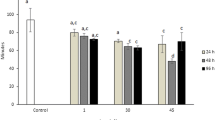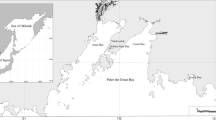Abstract
The effect of tributyltin (TBT) on the stability of hemocytic lysosome membranes of the mussel, Mytilus galloprovincialis, and the use thereof as a biomarker of TBT-induced stress, was investigated. Mussels were exposed to 0.1 and 1.0 µg/L tributyltin respectively for 4 weeks. Lysosomal membrane stability of hemocytes was tested weekly by means of the neutral red retention time (NRRT) assay, after which the mussel samples were analyzed for TBT content. The two exposed groups exhibited significantly increased (p < 0.05) whole body TBT concentrations with concomitant significant decreases (p < 0.05) in NRRT (R2 values of 0.85 and 0.971 for lower and higher exposure groups, respectively). The higher exposure group showed a typical dose–response curve. For the control, no TBT was detected and NRRT remained stable. It was concluded that the NRRT assay could be considered as a useful technique, and lysosomal membrane destabilization a useful early warning and cellular biomarker of stress due to TBT exposure in M. galloprovincialis.


Similar content being viewed by others
References
Da Ros L, Moschino V, Macic V, Schintu M (2011) An ecotoxicological approach for the Boka Kotorska Bay (south-eastern Adriatic Sea): first evaluation of lysosomal responses and metallothionein induction in mussels. Mar Pollut Bull 63:326–333
Dailianis S, Domouhtsidou GP, Raftopoulou E, Kaloyianni M, Dimitriadis VK (2003) Evaluation of neutral red retention assay, micronucleus test, acetylcholinesterase activity and a signal transduction molecule (cAMP) in tissues of Mytilus galloprovincialis (L.), in pollution monitoring. Mar Environ Res 56:443–470
Dallas LJ, Cheung VV, Fisher AS, Jha AN (2013) Relative sensitivity of two marine bivalves for detection of genotoxic and cytotoxic effects: a field assessment in the Tamar Estuary, South West England. Environ Monit Assess 185:3397–3412
Fatoki OS, Okoro HK, Adekola FA, Ximba BJ, Snyman RG (2012) Bioaccumulation of metals in black mussels (Mytilus galloprovincialis) in Cape Town Harbour, South Africa. Environmentalist 32:48–57
Fernley PW, Moore MN, Lowe DM, Donkin P, Evans S (2000) Impact of the Sea Empress oil spill on lysosomal stability in mussel blood cells. Mar Environ Res 50:451–455
Fiorini R, Pagliarani A, Nesci S, Pirini M, Tucci E, Ventrella V (2012) Structural and functional changes in gill mitochondrial membranes from the Mediterranean mussel Mytilus galloprovincialis exposed to tri-n-butyltin. Environ Toxicol Chem 31:877–884
Furdek M, Vahčič M, Ščančar J, Milačič R, Kniewald G, Mikac N (2012) Organotin compounds in seawater and Mytilus galloprovincialis mussels along the Croatian Adriatic Coast. Mar Pollut Bull 64:189–199
Gopalakrishnan S, Huang W, Wang Q, Wu M, Liu J, Wang K (2011) Effects of tributyltin and benzo [a] pyrene on the immune-associated activities of hemocytes and recovery responses in the gastropod abalone, Haliotis diversicolor. Comp Biochem Physiol C Toxicol Pharmacol 154(2):120–128
Hagger JA, Depledge MH, Galloway TS (2005) Toxicity of tributyltin in the marine mollusc Mytilus edulis. Mar Pollut Bull 51:811–816
Hoch M (2001) Organotin compounds in the environment- an overview. Appl Geochem 16:719–743
Hsia PM, Liu SM (2003) Accumulation of organotin compounds in Pacific oysters, Crassostrea gigas, collected from aquaculture sites in Taiwan. Sci Total Environ 313:41–48
Hung TC, Hsu WK, Meng PJ, Chuang A (2001) Organotins and imposex in the rock shell, Thais clavigera, from oyster mariculture areas in Taiwan. Environ Pollut 112:145–152
Inoue S, Oshima Y, Usuki H, Hanamura Y, Kai N, Shimasaki Y, Honjo T (2006) Effects of tributyltin maternal and/or waterborne exposure on the embryonic development of the Manila clam, Ruditapes philippinarum. Chemosphere 63:881–888
Jussila J, Jago J, Tsvetnenko E, Dunstan B, Evans LH (1997) Total and differential haemocyte counts in western rock lobsters (Panulirus cygnus George) under post-harvest stress. Mar Freshwater Res 48:863–867
Koukouzika K, Dimitriadis VK (2005) Multiple biomarker comparison in Mytilus galloprovincialis from the Greece Coast: “Lysosomal membrane stability, neutral red retention, micronucleus frequency and stress on stress”. Ecotoxicology 14:449–463
Lee CC, Wang T, Hsieh CY, Tien CJ (2005) Organotin contamination in fishes with different living patterns and its implications for human health risk in Taiwan. Environ Pollut 137:198–208
Lee CC, Hsieh CY, Tien CJ (2006) Factors influencing organotin distribution in different marine environmental compartments and their potential health risk. Chemosphere 65:547–559
Liscio C, Carro DM, Magi E (2009) Comparison of two analytical methods for the determination of organotin compounds in marine organisms. Comptes Rendus Chimie 12:831–840
Lopes-Dos-Santos RMA, Almeida C, Pereira MDL, Barroso CM, Galante-Oliveira S (2014) Morphological expression and histological analysis of imposex in Gemophos viverratus (Kiener, 1834) (Gastropoda: Buccinidae): a new bioindicator of tributyltin pollution on the West African coast. J Molluscan Stud. doi:10.1093/mollus/eyu037
Lowe DM, Pipe RK (1994) Contaminant induced lysosomal membrane damage in marine mussel digestive cells: an in vitro study. Aquat Toxicol 30:357–365
Lowe DM, Soverchia C, Moore MN (1995a) Lysosomal membrane responses in the blood and digestive cells of mussels experimentally exposed to fluoranthene. Aquat Toxicol 33:105–112
Lowe DM, Fossato VU, Depledge NH (1995b) Contaminant-induced lysosomal membrane damage in blood cells of mussels Mytilus galloprovincialis from the Venice Lagoon: an in vitro study. Mar Ecol Prog Ser 129:189–196
Marshall DJ, Rajkumar A (2003) Imposex in the indigenous Nassarius kranssianus (Mollusca: Neagastropoda) from South African harbours. Mar Pollut Bull 46:1150–1155
Nemanic TM, Leskovsek H, Horvat M, Vriser B, Bolje A (2002) Organotin compounds in the marine environment of the Bay of Piran, Northern Adriatic Sea. J Environ Monit 4:426–430
Okoro HK, Fatoki OS, Adekola FA, Ximba BJ, Snyman RG, Opeolu B (2011) Human exposure, biomarkers and fate of organotins in the environment. Rev Environ Contam Toxicol 213:27–54
Okoro HK, Fatoki OS, Adekola FA, Ximba BJ, Snyman RG (2012) Development of an analytical method for the speciation of organotin compounds in seawater, sediment and mussel samples using GC-FPD and GCMS-TOF. Pol J Environ Stud 21(6):1743–1753
Okoro HK, Fatoki OS, Adekola FA, Ximba BJ, Snyman RG (2013) Spatio-temporal variation of organotin compounds in seawater and sediments from Cape Town Harbour, South Africa using gas chromatography with flame photometric detector (GC-FPD). Arab J Chem. doi:10.1016/j.arabjc.2013.05.014
Pagliarani A, Bandiera P, Ventrella V, Trombetti F, Pirini M, Borgatti AR (2006) Response to alkyltins of two Na+-dependent ATPase activities in Tapes phillipinarum and Mytilus galloprovincialis. Toxicol In Vitro 20:1145–1153
Ringwood AH, Conners DE, Hoguet J (1998) Effects of natural and anthropogenic stressors on lysosomal destabilization in oysters Crassostrea virginica. Mar Ecol Prog Ser 166:163–171
Roach AC, Wilson SP (2009) Ecological impacts of tributyltin on estuarine communities in the Hastings River, NSW Australia. Mar Pollut Bull 58:1780–1786
Salazar MH, Salazar SM (1991) Assessing site-specific effects of TBT contamination with mussel growth rate. Mar Environ Res 32:131–150
Sheikh MA, Noah NM, Tsuha K, Oomori T (2007) Occurrence of tributyltin compounds and characteristics of heavy metals. Int J Environ Sci Technol 4(1):49–59
Siah A, Pellerin J, Amiard JC, Pelletier E, Viglino L (2003) Delayed gametogenesis and progesterone levels in soft-shell clams (Mya arenaria) in relation to in situ contamination to organotins and heavy metals in the St. Lawrence River (Canada). Comp Biochem Physiol C Toxicol Pharmacol 135(2):145–156
Snyman RG, Reinecke A, Reinecke AJ (2000) Hemocytic lysosome response in the snail Helix aspersa after exposure to the fungicide copper oxychloride. Arch Environ Contam Toxicol 39:480–485
Svendsen C, Weeks JM (1995) The use of a lysosome assay for the rapid assessment of cellular stress from copper to the freshwater snail Viviparus contectus (Millet). Mar Pollut Bull 31(1–3):139–142
Transnet National Ports Authority (2010) Cape Town Harbour. www. ports.co.za
Yakan SD, Henkelmann B, Schramm KW, Okay OS (2011) Bioaccumulation depuration kinetics and effects of benzo (a) anthracene on Mytilus galloprovincialis. Mar Pollut Bull 63:471–476
Zhou QF, Li ZY, Jiang GB, Yang RQ (2003) Preliminary investigation of a sensitive biomarker of organotin pollution in Chinese coastal aquatic environment and marine organisms. Environ Pollut 125:301–304
Acknowledgments
The authors wish to thank the Cape Peninsula University of Technology, Cape Town, South Africa, for financial support for data collection and analyses, as well as the University of Ilorin, Ilorin, Nigeria, for a staff development grant for the main author.
Ethical standard
This study was evaluated and approved by the Ethics Committee of the Faculty of Applied Sciences, Cape Peninsula University of Technology. It complies with the requirements set by the Ethics Review Board, CPUT, and with environmental legislation of the Republic of South Africa.
Author information
Authors and Affiliations
Corresponding author
Rights and permissions
About this article
Cite this article
Okoro, H.K., Snyman, R.G., Fatoki, O.S. et al. Lysosomal Membrane Stability of the Mussel, Mytilus galloprovincialis (L.), as a Biomarker of Tributyltin Exposure. Bull Environ Contam Toxicol 94, 609–613 (2015). https://doi.org/10.1007/s00128-015-1526-4
Received:
Accepted:
Published:
Issue Date:
DOI: https://doi.org/10.1007/s00128-015-1526-4




